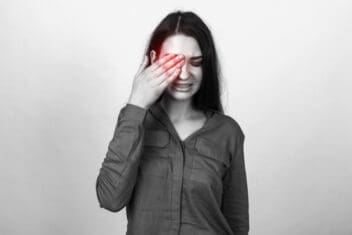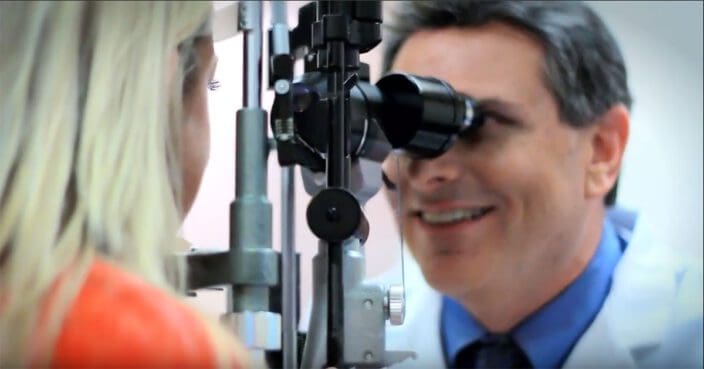
Medically Reviewed by Angelique J. Pillar, M.D.
How to Treat Corneal Edema: Products, Surgery & More
Home / Eye Conditions & Eye Diseases /
Last Updated:

Medically Reviewed by Angelique J. Pillar, M.D.
Your cornea is a clear, multilayered organ on the surface of your eye, responsible for refracting light onto your retina. Damage to this organ can lead to vision problems, which may include blurry, double, or painful vision from corneal edema.
Table of Contents
Corneal edema, or swelling of the cornea, is typically a symptom of an underlying problem. This could be trauma from surgery or an injury, inflammation from an infection, a genetic or congenital disease, or harm from a toxic chemical.
There are several potential treatments for corneal edema, ranging from monitoring the progress of a chronic disease, to using eye drops to reduce swelling or dehydrate the cornea. If your cornea becomes seriously damaged from edema, or the edema does not go away with other treatment, you may need to have your cornea partially or fully replaced.
Ultimately, corneal edema is very treatable. Your eye doctor can identify the issue through regular eye exams. If you notice a sudden change in your vision, schedule an appointment.
Corneal Edema: A Symptom of an Underlying Issue

The cornea is a clear, multilayered structure on the front of your eye, over the pupil. This part of your eye focuses light onto the retina, a cluster of photoreactive cells at the back of your eye.
The retina sends signals through the optical nerve to the brain, where these signals are interpreted as images. If there is something wrong with your cornea, then your retina will not get enough focused light, and your brain will not interpret clear images from what your retina sends.
You deserve clear vision. We can help.
With 135+ locations and over 2.5 million procedures performed, our board-certified eye surgeons deliver results you can trust. Your journey to better vision starts here.
Your cornea could suffer damage from an injury, surgery, or illness. This could cause corneal edema, a condition in which this layer of tissue swells. Corneal edema is a symptom of an underlying issue rather than an illness itself. However, it should be treated along with the underlying cause, so you can best maintain your sight.
If you are diagnosed with corneal edema, your ophthalmologist may prescribe a specific treatment plan based on what caused the problem. Treatment can include wearing glasses instead of contact lenses, specialized eye drops, or surgery.
What Causes Corneal Edema?
The human cornea should maintain 78 percent hydration. If the cornea retains more moisture than that, it could swell. This damages the internal structures and could cause corneal opacity, or clouding, which makes it difficult to see through the organ.
Your cornea may become thicker too, which changes how light is refracted to your retina. These problems can cause blind spots, blurry vision, discomfort in your eyes, or double vision.
There are four groups of problems that can cause the cornea to swell, leading to corneal edema.
- Mechanical issues: Problems with the mechanics of the cornea are typically caused by trauma to the eye. This could be from an accident, eye surgery, or elevated intraocular pressure, which is associated with glaucoma.
- Corneal dystrophy: Dystrophy is a problem involving genetic based factors in keeping healthy the cells that keep the cornea clear. There are four major types of corneal dystrophy:
- Fuchs’ corneal dystrophy
- Posterior polymorphous corneal dystrophy
- Congenital hereditary endothelial corneal dystrophy
- X-linked endothelial corneal dystrophy
These are genetic diseases with progressive symptoms in which abnormal material accumulates in the outer layer of the eye. Corneal edema is one progressive symptom of these issues.
- Inflammatory causes: Conditions that can inflame the cornea can cause it to swell with more water as a reaction to physical damage. These are the most common causes of inflammation:
- Primary endotheliitis
- Uveitis
- Stromal viral keratitis
- Trabeculitis
When the iris or the trabecular meshwork are damaged from inflammation, often associated with a bacterial or viral disease, endothelial cells from one layer of the cornea can move into another. White blood cells may also enter several layers of the cornea, which can increase corneal edema and put these tissues at risk of further damage.
- Toxicity: Chemicals entering the eye, whether due to eye surgery or from an accident, can cause damage to the cornea that leads to swelling. Toxic effects may be acute and require hospital treatment, or they can be chronic, causing progressive damage to the eye.
Treatment Approaches to Managing Corneal Edema

Depending on the severity of your corneal edema and the underlying problem, you will receive different approaches to treatment. Some causes, like early stage corneal dystrophy, may not require direct medical treatment or surgery, just monitoring from an ophthalmologist. Other conditions, like infections or injuries, may require surgery.
Here are the most common medical treatments to corneal edema, based on the underlying cause:
- Contact lens habit changes: Sometimes, wearing contact lenses for too long throughout the day or for too many days in a row can cause temporary corneal edema. Removing contact lenses and wearing glasses instead for several days or even weeks, depending on the recommendation of your ophthalmologist, can allow your corneas to recover.
- Evaporation: In mild or moderate cases of corneal edema, some people have noticed that their vision is blurrier in the morning than at night. Although you should still talk to your ophthalmologist about underlying causes, it is possible that they will recommend finding ways to allow greater evaporation in the morning if you do not need more intensive treatment. This may include a practice as simple as using a hairdryer to blow air across your eyes from a safe distance.
- Inflammation and infection: Your eye doctor will prescribe corticosteroid eye drops to reduce inflammation, either because of a viral infection or after corneal surgery.
- Intraocular pressure: Carbonic anhydrase inhibitors are a type of medication that lowers fluid pressure in the eye, in both acute and chronic situations. High fluid pressure is associated with glaucoma, which can also cause swelling in the cornea that would further damage eyesight.
- Tearing agents: Hypertonic agents improve the quality of your tears, which can ease corneal edema if the problem is on the epithelium, the upper layer of cells. Stromal edema, in the lower layers of corneal cells, is harder to treat with eye drops.
Another agent used in a similar situation is polyoxyethylene, which pulls water out of the cornea to reduce swelling. The most intensive, hydrophobic solution is anhydrous glycerine, which can sting the eyes and lead to photophobia, or sensitivity to light, as a long-term side effect. - Bandage contact lenses: Sometimes, damage to the cornea from an accident or after surgery requires protection. Although constantly wearing contact lenses can cause mild corneal edema, bandage contact lenses are made to allow more oxygen transmissibility. They are used as a temporary solution, while waiting for further medical treatment for the underlying cause.
You deserve clear vision. We can help.
With 135+ locations and over 2.5 million procedures performed, our board-certified eye surgeons deliver results you can trust. Your journey to better vision starts here.
Damage From Corneal Edema May Require Surgery

Chronic forms of corneal edema, along with severe and acute corneal edema, may require surgery. Laser eye surgeries that relieve intraocular pressure can help to reduce corneal edema indirectly. If there is a serious problem with the cornea itself that leads to swelling, you may need to have your cornea, or some layers of your cornea, replaced.
- Descemet membrane endothelial keratoplasty (DMEK): This procedure is a partial corneal replacement. It involves stripping a layer called the Descemet membrane and the endothelium, and then transplanting a new membrane with the attached endothelial cells.
- Descemet’s stripping endothelial keratoplasty (DSEK): This procedure is a partial corneal replacement. It involves stripping a layer called the Descemet membrane and the endothelium, and then transplanting a thin layer of donor corneal stroma along with the donor Descememt membrane and endothelial cells.
- Penetrating keratoplasty (PK): This is a full replacement of the cornea, which may become so damaged due to underlying diseases associated with corneal edema that your vision may be impacted.
Corneal Edema Is Very Treatable
Sometimes, corneal edema is associated with a vitamin deficiency. While eating healthy foods and taking vitamins as needed can improve your overall health and reduce your risk of corneal edema, there are many other underlying causes that may require more serious medical treatment. Ignoring sudden changes in your vision, pain or discomfort in your eyes, or tear problems can make underlying chronic issues with your vision worse, so see an ophthalmologist for a diagnosis and treatment plan.
Corneal edema can be treated with several different approaches, from eye drops to surgery. Follow your eye doctor’s guidance to keep your vision as clear as possible, for as long as possible.
You deserve clear vision. We can help.
With 135+ locations and over 2.5 million procedures performed, our board-certified eye surgeons deliver results you can trust. Your journey to better vision starts here.
References
- Structures and Function of the Cornea. National Eye Institute (NEI).
- Corneal Edema. Bausch + Lomb.
- Corneal Oedema and Its Medical Treatment. (2013). Clinical and Experimental Optometry. Optometrists Association Australia.
- What Is Corneal Dystrophy? The Corneal Dystrophy Foundation (CDF).
- Dystrophy. Merriam-Webster.
- Descemet’s Stripping Automated Endothelial Keratoplasty (DSAEK). (April 2016). Ophthalmology and Visual Sciences, University of Iowa Healthcare.
- Descemet’s Membrane Endothelial Keratoplasty. (April 2016). Ophthalmology and Visual Sciences, University of Iowa Healthcare
- Penetrating Keratoplasty (PK). (February 2016). Ophthalmology and Visual Sciences, University of Iowa Healthcare.

Angelique J. Pillar, MD is a fellowship trained and board certified ophthalmologist specializing in cataract, cornea, and refractive surgery.
This content is for informational purposes only. It may have been reviewed by a licensed physician, but is not intended to serve as a substitute for professional medical advice. Always consult your healthcare provider with any health concerns. For more, read our Privacy Policy and Editorial Policy.